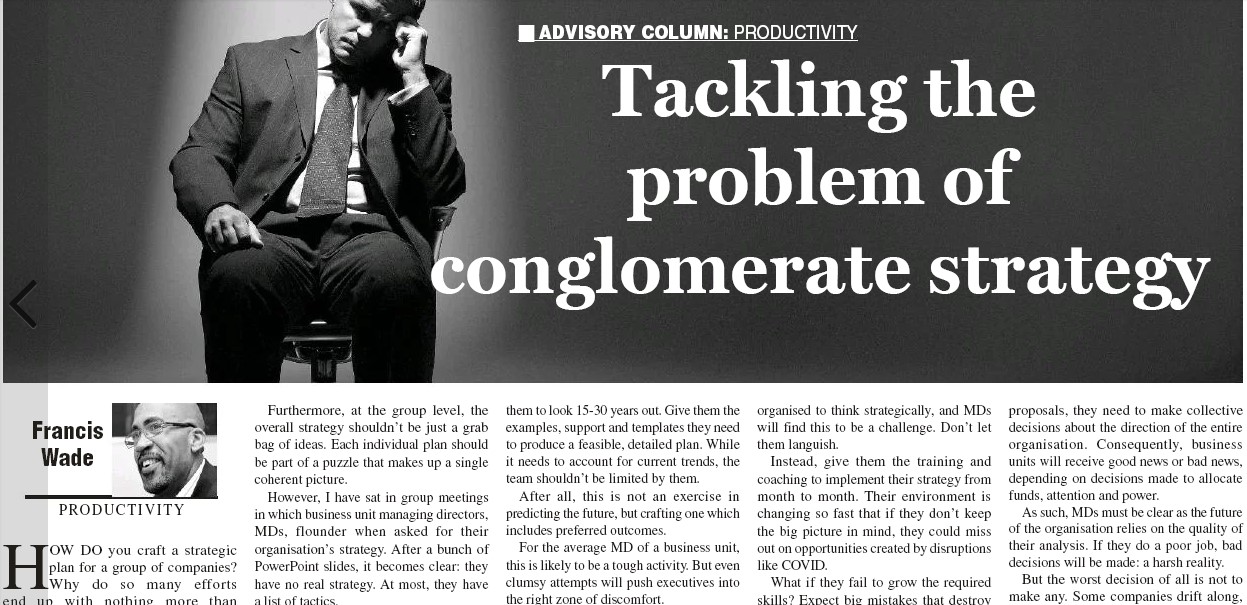How do you craft a strategic plan for a group of companies? Why do so many efforts end up with nothing more than “last-year’s-plan-plus-5%?” Discard this path of least resistance if you hope to capitalize on COVID opportunities.
Conglomerates are, in the best of times, difficult to plan for. Units compete for resources in different markets, creating a headache for whoever must make an optimal allocation. It’s a challenge of comparing apples to oranges by executives who don’t specialize in either fruit.
The hope is that by the end of the day, each business unit has a unique set of marching orders: a custom “breakthrough strategy”. It should be powerful enough to meet customer’s unmet needs, conform to disruptive technology trends and prevent competitors from gaining a foothold.
Furthermore, at the group level, the overall strategy shouldn’t be just a grab bag of ideas. Each individual plan should be part of a puzzle that makes up a single coherent picture.
However, I have sat in group meetings in which business unit MD’s flounder when asked for their organization’s strategy. After a bunch of PowerPoint slides, it becomes clear: they have no real strategy. At most, they have a list of tactics.
Furthermore, in these pandemic times, most are facing game-changing disruptions. This requires them to engineer the “next normal.” More often than not, they simply aren’t equipped to get the job done.
Before your business units drift into becoming another Nokia or Blackberry (i.e. a has-been), how can your group of companies prevent its component businesses from failing?
Step 1 – Engage business units in long-term planning
The simplest request is for business units to lengthen their planning horizons. Ask them to look 15-30 years out. Give them the examples, support and templates they need to produce a feasible, detailed plan. While it needs to account for current trends, the team shouldn’t be limited by them.
After all, this is not an exercise in predicting the future, but crafting one which includes preferred outcomes.
For the average MD of a business unit, this is likely to be a tough activity. But even clumsy attempts will push executives into the right zone of discomfort.
Step 2 – Develop leaders’ everyday planning skills
To improve C-suite skills, don’t turn strategy into a onetime or annual event. Instead, train them to think strategically at all times.
Some group CEO’s mistakenly assume this is easy. In their role, they spend 80% of their time on strategy, and 20% on daily operations. However, the reverse is true for their business unit MD’s. The fact is, in their progress up the ranks, the drumbeat for immediate results kept them awake at night. Their ability to adapt quickly helped them get promoted.
As such, your organization may not be organized to think strategically, and MD’s will find this to be a challenge. Don’t let them languish.
Instead, give them the training and coaching to implement their strategy from month to month. Their environment is changing so fast that if they don’t keep the big picture in mind, they could miss out on opportunities created by disruptions like COVID.
What if they fail to grow the required skills? Expect big mistakes that destroy value and produce a “diversification discount” in which the sum of the parts of your company is greater than the whole.
Step 3 – Make Clear Proposals
Once a business unit has completed its planning, MD’s must advance proposals to the central group organization. This is pure lobbying: an appeal to support the business unit’s strategic plan with tangible resources.
Your leaders may also need to be trained to become balanced, fact-based advocates of the specific value they can bring in the mid to long term.
Their clarity is essential. Why?
As group executives hear a range of proposals, they need to make collective decisions about the direction of the entire organization. Consequently, business units will receive good news or bad news depending on decisions made to allocate funds, attention and power.
As such, MD’s must be clear as the future of the organization relies on the quality of their analysis. If they do a poor job, bad decisions will be made: a harsh reality.
But the worst decision of all is not to make any. Some companies drift along, sitting back to watch what happens next.
By then, the savviest staff members have found jobs elsewhere, looking for real leaders to follow. Customers uncover better products and services, and value is destroyed.
While it’s hard to marshal a conglomerate strategy, it’s a problem which must be tackled to assure the future of the entire organization.

